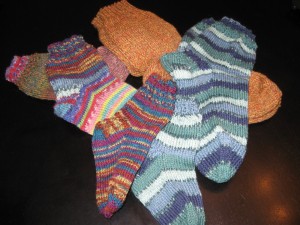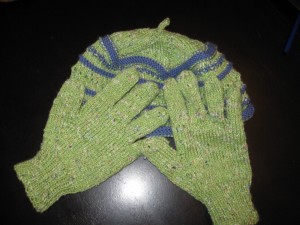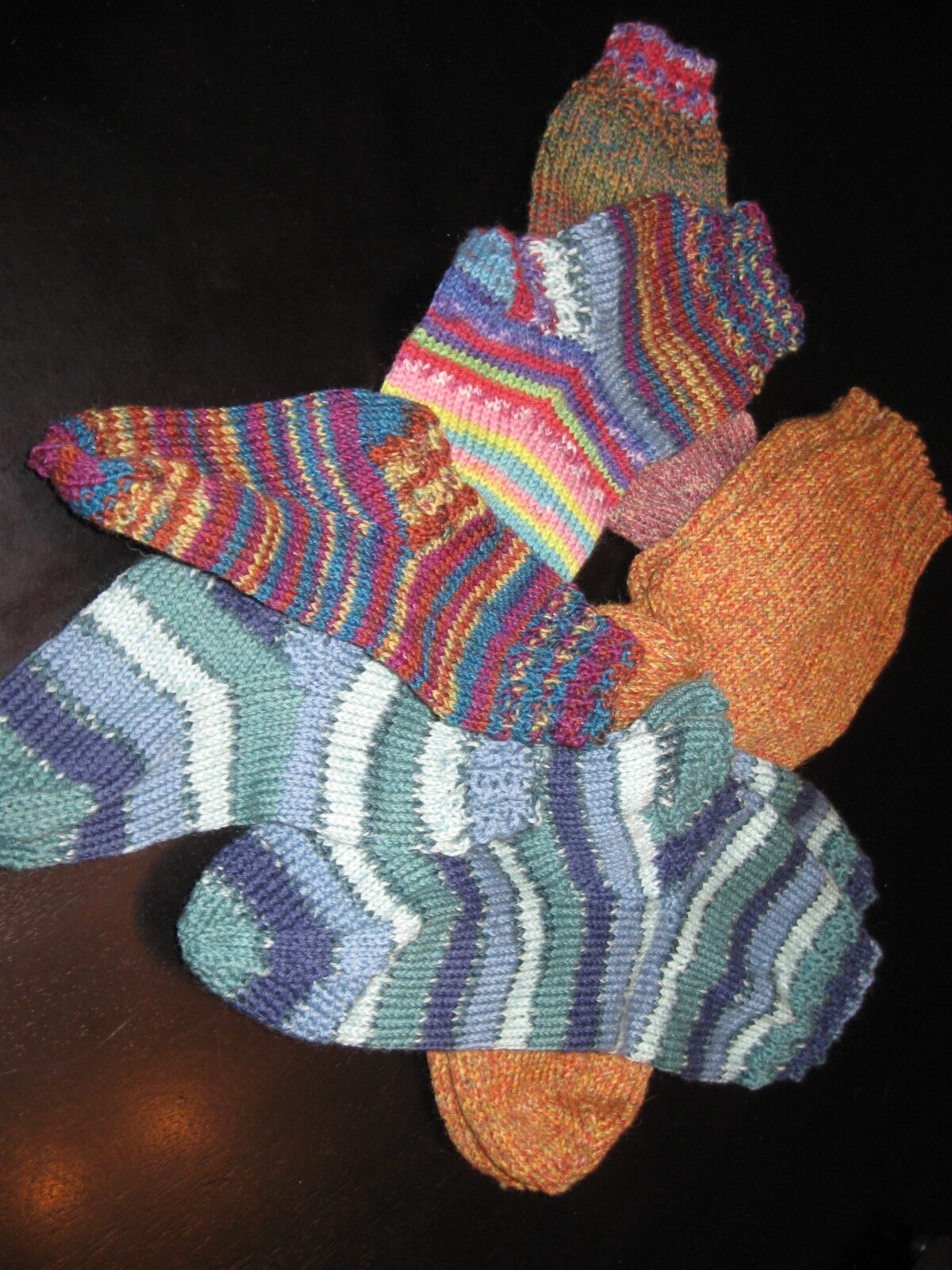
Wintertime is my time for knitting. Every year (or almost every, I should say) about the time it starts to get cooler I begin wondering where I stashed that bag of yarn I found on sale. The yarn slips through the fingers so nicely in the cooler months… plus there is that feeling of wanting to wear some nice, warm socks, gloves, scarves, hats… I’ve almost run out of sock yarn in the past few weeks… the picture is a pile of the socks I’ve made recently.
I’m currently working on a pair of gloves (not a beginning project, but really fun on double-pointed needles for the more experienced).

I learned to knit from a neighbor lady, Mrs. Easton, who lived across the street from our home when I was about 7 years old. Having attempted to teach a 7-year old to knit, I can now fully appreciate the patience that dear lady must have had. For several weeks in a row, I’d go over to her house at a specified time and learn the basics of knitting.
She taught me how to rewind my skeins of yarn into nice, round balls of yarn with the starting thread sticking out from the middle. It is ever so much nicer to pull from the middle so that your yarn doesn’t roll across the room with every pull as you are knitting. I’ll admit that I tend to dig around in the skeins and find the “pull from the middle” thread without rewinding usually, but I know how to do it if need be!
Then, she taught me the basics of casting on using the “Knitting-on” method. Using a burgundy maroon wool yarn and size 8 needles, we began making a (very lovely – you can imagine how the first project made by a 7 year old looked) potholder.
I found a nice YouTube video demonstrating this method here:
It is an excellent method of casting on, leaving a nice finish on the edge, while remaining stretchy. This is the method I use most often even still, after all these years.
Next, Mrs. Easton taught me to knit using the “Knit” stitch. Another YouTube demonstration showing this method is here:
When each row is knitted using the Knit stitch only, you end up with a pattern called the Garter Stitch. This gives a sort of horizontal ribbed pattern to your knitting.
She also taught me how to knit using the Purl stitch. This stitch is the opposite of the knit stitch. Using this stitch on alternate rows creates what is called the stockinette stitch. Alternating knitting and purling within a row can create a vertical ribbing and is commonly seen at the edges of projects like sweaters, mittens, gloves, etc. I found an online video demonstrating this stitch as well (she also demonstrates how to bind off using a purl stitch method).
She also taught me the proper way to hold my thread to keep a steady tension. Now at that point I had no idea there were so many different ways to hold the yarn… Pinky wrap (that’s the method I use), continental, throwing… and many variations on each. This video gives a reasonable explanation of the method, although it is not the favorite of the person demonstrating… feel free to investigate other methods and find what suits you. I find my knitting to be of very even tension and matches the knitting gauge pretty closely using this method, so I’m not changing!
Finally, after many weeks of struggling with dropped stitches (she helped me fix the mistakes, but still there were a few “holes” where my errors were evident), gaining the coordination to knit row after row… I had an almost 8” square knitted potholder. The final thing was to learn to bind off. This video gives a very simple demonstration of that technique.
With these simple techniques, you have the basics of everything there is in knitting. Everything you find in patterns will be these skills or a variation of one or more of them. This was the full extent of my toolbox when I began. By buying knitting magazines, or some books with beginner patterns, you can start from here and learn to knit anything… color combinations, knitting on double-pointed needles, felting… the world of knitting is fascinating and useful.

I buy yarn when I find it on sale, most often. I’m always thinking about projects for the next winter and looking whenever I’m in a fabric or craft store. I also love buying yarn online from www.KnitPicks.com . I think they often have yarn at a very good price and have a great selection of colors and types of yarn.
Over the years I have accumulated a pretty large collection of books that have many different methods and stitch patterns, as well as methodology for creating your own patterns using various types of yarns and needles. I once had the great good fortune to buy a lot at an auction of things gathered by another avid knitter of a previous generation. I have a huge collection of knitting needles in varying sizes from that great find.
Really, knitting is a wonderful skill to have on the homestead. I highly recommend you investigate it (or renew your interest in it).
Check out my friend Tiffany’s lovely knitting project here: Alpaca Mitts – really beautiful. Tiffany is much more adventurous on intarsia knitting and does some really complex patterns… I’m hoping for more of her projects to be posted over there.
There is also an entire community of knitters sharing ideas, projects, photos, etc. over at Ravelry.com. I don’t post much over there, but have been very amazed and impressed with some of the beautiful work submitted by members.

